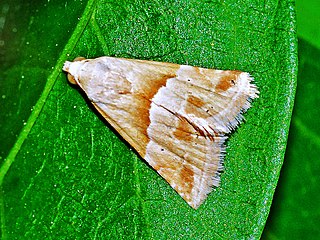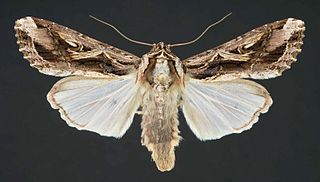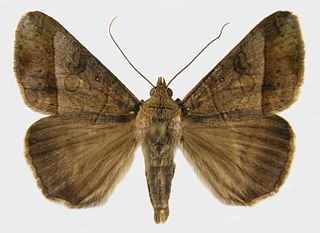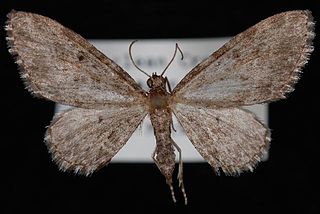
Moths are a group of insects that includes all members of the order Lepidoptera that are not butterflies. They were previously classified as suborder Heterocera, but the group is paraphyletic with respect to butterflies and neither subordinate taxa are used in modern classifications. Moths make up the vast majority of the order. There are thought to be approximately 160,000 species of moth, many of which have yet to be described. Most species of moth are nocturnal, although there are also crepuscular and diurnal species.

Lymantria dispar, also known as the gypsy moth or the spongy moth, is an Eurasian species of moth in the family Erebidae. Lymantria dispar is subdivided into several subspecies, with subspecies such as L. d. dispar and L. d. japonica being clearly identifiable without ambiguity. Lymantria dispar has been introduced to several continents and is now found in Europe, Africa, Asia, North America and South America. The polyphagous larvae live on a variety of deciduous and coniferous trees and can cause severe damage in years of mass reproduction. Due to these features, Lymantria dispar is listed among the world's 100 worst invasive alien species.

The luna moth, also called the American moon moth, is a Nearctic moth in the family Saturniidae, subfamily Saturniinae, a group commonly named the giant silk moths.

Hickory is a common name for trees composing the genus Carya, which includes around 18 species. Five or six species are native to China, Indochina, and India (Assam), as many as twelve are native to the United States, four are found in Mexico, and two to four are native to Canada. A number of hickory species are used for their edible nuts, lumber or other wood and woodcraft products.

The Pyralidae, commonly called pyralid moths, snout moths or grass moths, are a family of Lepidoptera in the ditrysian superfamily Pyraloidea. In many classifications, the grass moths (Crambidae) are included in the Pyralidae as a subfamily, making the combined group one of the largest families in the Lepidoptera. The latest review by Eugene G. Munroe and Maria Alma Solis retain the Crambidae as a full family of Pyraloidea.

The Calpinae are a subfamily of moths in the family Erebidae described by Jean Baptiste Boisduval in 1840. This subfamily includes many species of moths that have a pointed and barbed proboscis adapted to piercing the skins of fruit to feed on juice, and in the case of the several Calyptra species of vampire moths, to piercing the skins of mammals to feed on blood. The subfamily contains some large moths with wingspans longer than 5 cm (2 in).

Arctia virginalis, the Ranchman's tiger moth, is a species of tiger moth in the family Erebidae. It was first described by Jean Baptiste Boisduval in 1852.
Forsebia is a genus of moths in the family Erebidae. The genus was described by Richards in 1936.

Eumacaria is a monotypic moth genus in the family Geometridae described by Packard in 1873. Its only species, Eumacaria madopata, the brown-bordered geometer moth, was first described by Achille Guenée in 1857. It is found in North America, where it has been recorded from British Columbia, northern Washington, southern Saskatchewan, from Maine to Florida, South Dakota, North Dakota, Nebraska, Wyoming, Idaho, Colorado and New Mexico. The habitat consists of orchards and shrublands. The species is listed as threatened in Connecticut.

Anomis erosa, the yellow scallop moth or abutilon moth, is a moth of the family Erebidae. The species was first described by Jacob Hübner in 1821. It is found in south-eastern North America. It is mostly a southern species, but migrants reach Manitoba, Quebec and Maine.

Drasteria adumbrata, the shadowy arches, is a moth of the family Erebidae. The species was first described by Hans Hermann Behr in 1870. It is found from coast to coast in southern Canada, south in the west to California and Colorado, south in the east to New England and Michigan. Subspecies D. a. alleni is found from eastern Alberta to New York and Nova Scotia. Subspecies D. a. saxea occurs from southern British Columbia and south-west Alberta south to California and Colorado.

Eublemma parva, the small marbled, is a moth of the family Erebidae. The species was first described by Jacob Hübner in 1808.

Spodoptera dolichos, the dolichos armyworm moth or sweetpotato armyworm moth, is a moth of the family Noctuidae. The species was first described by Johan Christian Fabricius in 1794. It is found from the southern United States, south through Costa Rica to South America, as far south as Argentina. In the United States, it may occur as far north as Kentucky and Maryland.

Mocis latipes, the small mocis moth or striped grass looper, is a species of moth of the family Erebidae. It is found from North America (from southern Ontario and Quebec to Florida, west to Arizona, north to Minnesota and south through Central to South America.

Eupithecia lachrymosa is a moth in the family Geometridae first described by George Duryea Hulst in 1900. It is found in North America from central Saskatchewan west to southern Vancouver Island, north to British Columbia and Alberta and south to California.

Eupithecia misturata is a moth in the family Geometridae first described by George Duryea Hulst in 1896. It is widely distributed in western North America.

Speranza is a genus of moths in the family Geometridae erected by John Curtis in 1828.

Macaria aequiferaria, the woody angle moth, is a moth of the family Geometridae. The species was first described by Francis Walker in 1861. It is found in North America, where it has been recorded from Maryland, and Delaware to Florida, west to Texas, as well as in Oklahoma, Mississippi, Kentucky and southern Illinois. It is also found in Mexico.

The Melipotini are a tribe of moths in the family Erebidae.
Forsebia mendozina is a moth of the family Erebidae. It is found in the Andes Mountains of Peru and Argentina.


















